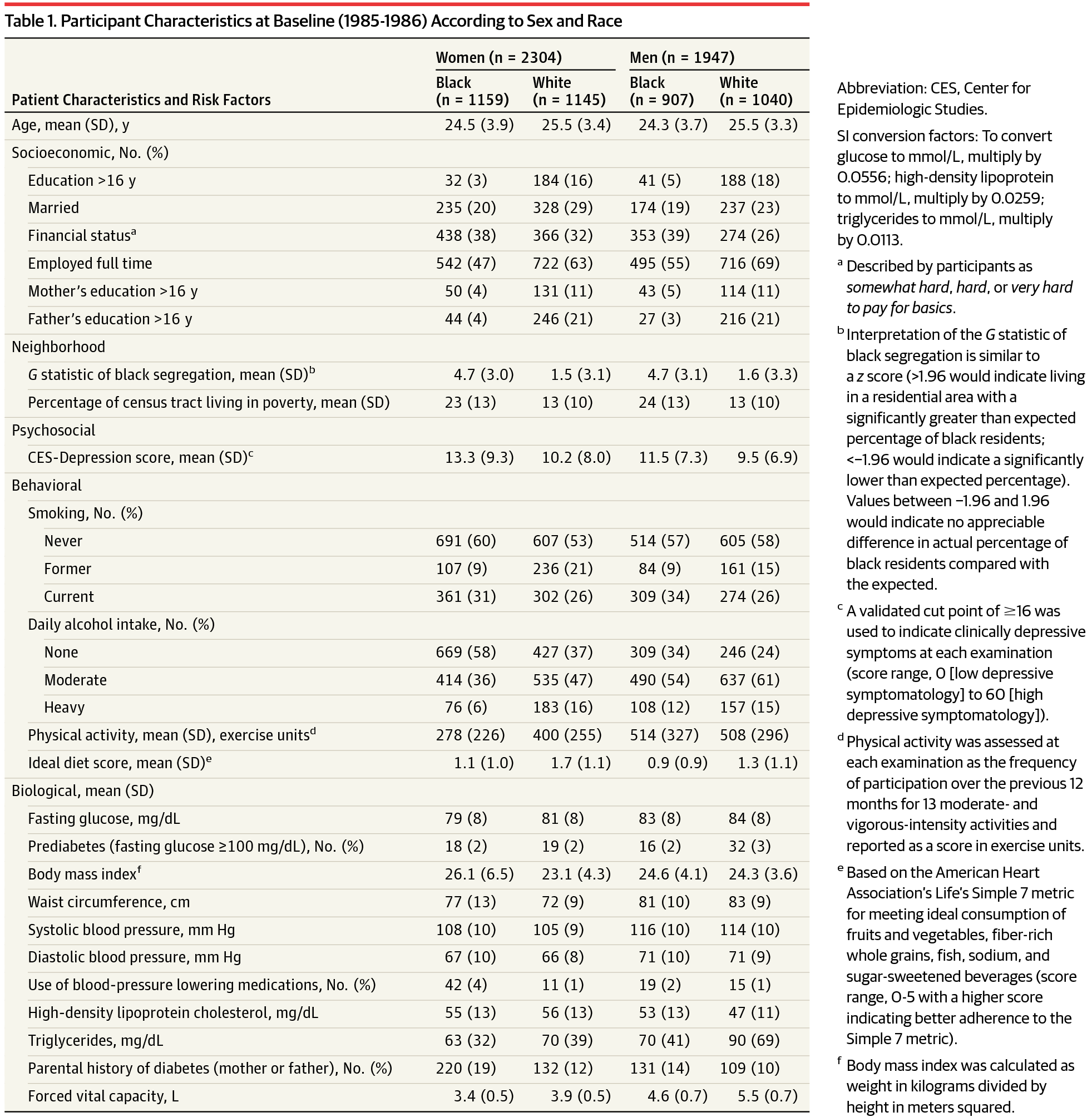Our official English website, www.x-mol.net, welcomes your
feedback! (Note: you will need to create a separate account there.)
Association of Modifiable Risk Factors in Young Adulthood With Racial Disparity in Incident Type 2 Diabetes During Middle Adulthood
JAMA ( IF 63.1 ) Pub Date : 2017-12-26 , DOI: 10.1001/jama.2017.19546 Michael P Bancks 1 , Kiarri Kershaw 1 , April P Carson 2 , Penny Gordon-Larsen 3 , Pamela J Schreiner 4 , Mercedes R Carnethon 1
JAMA ( IF 63.1 ) Pub Date : 2017-12-26 , DOI: 10.1001/jama.2017.19546 Michael P Bancks 1 , Kiarri Kershaw 1 , April P Carson 2 , Penny Gordon-Larsen 3 , Pamela J Schreiner 4 , Mercedes R Carnethon 1
Affiliation

|
Importance In the United States, black individuals are twice as likely to develop type 2 diabetes compared with white individuals, and these disparities are particularly pronounced in young and middle age. Prior studies have identified differences in traditional risk factors that may be associated with racial disparities in diabetes incidence but have not simultaneously adjusted for risk factors measured across multiple domains (eg, the individual and the environment) and updated over time. Objective To determine the relative associations of modifiable biological, neighborhood, psychosocial, socioeconomic, and behavioral factors in young adulthood with the observed racial disparity in diabetes incidence between middle-aged black and white individuals. Design, Setting, and Participants Black and white men and women from the observational Coronary Artery Risk Development in Young Adults study, aged 18 to 30 years, without diabetes at baseline (1985-1986; N = 4251) were observed through 2015-2016. Sex-stratified multivariable-adjusted Cox proportional hazards modeling, with adjustment for time-updated covariates, was used to estimate risk for incident diabetes. Percent reduction in the &bgr; coefficient (the logarithm used to calculate the hazard ratio [HR]) was calculated to compare black to white participants. Exposures Self-identified race and factors including biological (eg, fasting glucose, body mass index), neighborhood (racial segregation and tract-level poverty), psychosocial (depressive symptoms), socioeconomic (eg, personal and parental educational attainment, current employment), and behavioral (eg, regular alcohol consumption, smoking) domains. Main Outcomes and Measures Incident type 2 diabetes mellitus. Results The mean (SD) age at baseline was 25 (3.6) years, 49% (n = 2066) of the sample was black, and 54% (n = 2304) were women. Over a mean follow-up of 24.5 years, 504 cases of incident diabetes were identified. Using sex-stratified multivariable-adjusted Cox proportional hazards models, black women and men were more likely to develop diabetes than white men and women (black women: HR, 2.86 [95% CI, 2.19-3.72] and risk difference [RD], 89 cases/1000 people [95% CI, 61-117]; black men: HR, 1.67 [95% CI, 1.28-2.17] and RD, 47 cases/1000 people [95% CI, 15-78]) after adjustment for age and center. Biological factors were most strongly associated with the disparity in diabetes risk between black and white individuals for women (percent reduction in &bgr;, 112%) and men (percent reduction in &bgr;, 86%). There was no longer disparity in diabetes risk between black and white middle-aged adults after adjustment for biological, neighborhood, psychosocial, socioeconomic, and behavioral factors measured over time (HR for women, 0.79 [95% CI, 0.55-1.14]; HR for men, 0.92 [95% CI, 0.62-1.38]). Conclusions and Relevance In this cohort study comparing black and white participants, there was a statistically significant increased risk of incident type 2 diabetes among black women and men. However, after adjustment for modifiable risk factors during young adulthood, the disparity was no longer statistically significant.
中文翻译:

青年期可改变危险因素与中年 2 型糖尿病发病种族差异的关联
重要性 在美国,黑人患 2 型糖尿病的可能性是白人的两倍,而且这种差异在年轻人和中年人中尤其明显。先前的研究已经确定了传统风险因素的差异,这些差异可能与糖尿病发病率的种族差异有关,但没有同时调整跨多个领域(例如个人和环境)测量的风险因素并随着时间的推移进行更新。目的 确定青年时期可改变的生物、邻里、社会心理、社会经济和行为因素与观察到的中年黑人和白人糖尿病发病率种族差异之间的相对关联。设计、背景和参与者 2015-2016 年观察了来自观察性年轻人冠状动脉风险发展研究的黑人和白人男性和女性,年龄为 18 至 30 岁,基线时(1985-1986 年;N = 4251)没有糖尿病。性别分层多变量调整 Cox 比例风险模型,并调整时间更新的协变量,用于估计糖尿病发生风险。 &bgr; 的减少百分比计算系数(用于计算风险比 [HR] 的对数)以比较黑人和白人参与者。暴露 自我认同的种族和因素,包括生物学(例如,空腹血糖、体重指数)、邻里关系(种族隔离和地区贫困)、社会心理(抑郁症状)、社会经济(例如,个人和父母的教育程度、当前就业)和行为(例如,经常饮酒、吸烟)领域。主要结果和措施 2 型糖尿病事件。结果 基线时的平均 (SD) 年龄为 25 岁 (3.6) 年,49% (n = 2066) 的样本是黑人,54% (n = 2304) 是女性。经过平均 24.5 年的随访,发现了 504 例糖尿病病例。使用性别分层多变量调整 Cox 比例风险模型,黑人女性和男性比白人男性和女性更容易患糖尿病(黑人女性:HR,2.86 [95% CI,2.19-3.72] 和风险差异 [RD], 89 例/1000 人 [95% CI, 61-117];黑人男性:调整后 HR,1.67 [95% CI,1.28-2.17] 和 RD,47 例/1000 人 [95% CI,15-78])对于年龄和中心。生物因素与黑人和白人之间女性(β 降低百分比,112%)和男性(β 降低百分比,86%)的糖尿病风险差异密切相关。随着时间的推移,对生物、邻里、社会心理、社会经济和行为因素进行调整后,黑人和白人中年人之间的糖尿病风险不再存在差异(女性 HR,0.79 [95% CI,0.55-1.14];HR男性为 0.92 [95% CI, 0.62-1.38])。结论和相关性 在这项比较黑人和白人参与者的队列研究中,黑人女性和男性患 2 型糖尿病的风险显着增加。然而,在调整青年时期可改变的危险因素后,这种差异不再具有统计学意义。
更新日期:2017-12-26
中文翻译:

青年期可改变危险因素与中年 2 型糖尿病发病种族差异的关联
重要性 在美国,黑人患 2 型糖尿病的可能性是白人的两倍,而且这种差异在年轻人和中年人中尤其明显。先前的研究已经确定了传统风险因素的差异,这些差异可能与糖尿病发病率的种族差异有关,但没有同时调整跨多个领域(例如个人和环境)测量的风险因素并随着时间的推移进行更新。目的 确定青年时期可改变的生物、邻里、社会心理、社会经济和行为因素与观察到的中年黑人和白人糖尿病发病率种族差异之间的相对关联。设计、背景和参与者 2015-2016 年观察了来自观察性年轻人冠状动脉风险发展研究的黑人和白人男性和女性,年龄为 18 至 30 岁,基线时(1985-1986 年;N = 4251)没有糖尿病。性别分层多变量调整 Cox 比例风险模型,并调整时间更新的协变量,用于估计糖尿病发生风险。 &bgr; 的减少百分比计算系数(用于计算风险比 [HR] 的对数)以比较黑人和白人参与者。暴露 自我认同的种族和因素,包括生物学(例如,空腹血糖、体重指数)、邻里关系(种族隔离和地区贫困)、社会心理(抑郁症状)、社会经济(例如,个人和父母的教育程度、当前就业)和行为(例如,经常饮酒、吸烟)领域。主要结果和措施 2 型糖尿病事件。结果 基线时的平均 (SD) 年龄为 25 岁 (3.6) 年,49% (n = 2066) 的样本是黑人,54% (n = 2304) 是女性。经过平均 24.5 年的随访,发现了 504 例糖尿病病例。使用性别分层多变量调整 Cox 比例风险模型,黑人女性和男性比白人男性和女性更容易患糖尿病(黑人女性:HR,2.86 [95% CI,2.19-3.72] 和风险差异 [RD], 89 例/1000 人 [95% CI, 61-117];黑人男性:调整后 HR,1.67 [95% CI,1.28-2.17] 和 RD,47 例/1000 人 [95% CI,15-78])对于年龄和中心。生物因素与黑人和白人之间女性(β 降低百分比,112%)和男性(β 降低百分比,86%)的糖尿病风险差异密切相关。随着时间的推移,对生物、邻里、社会心理、社会经济和行为因素进行调整后,黑人和白人中年人之间的糖尿病风险不再存在差异(女性 HR,0.79 [95% CI,0.55-1.14];HR男性为 0.92 [95% CI, 0.62-1.38])。结论和相关性 在这项比较黑人和白人参与者的队列研究中,黑人女性和男性患 2 型糖尿病的风险显着增加。然而,在调整青年时期可改变的危险因素后,这种差异不再具有统计学意义。











































 京公网安备 11010802027423号
京公网安备 11010802027423号